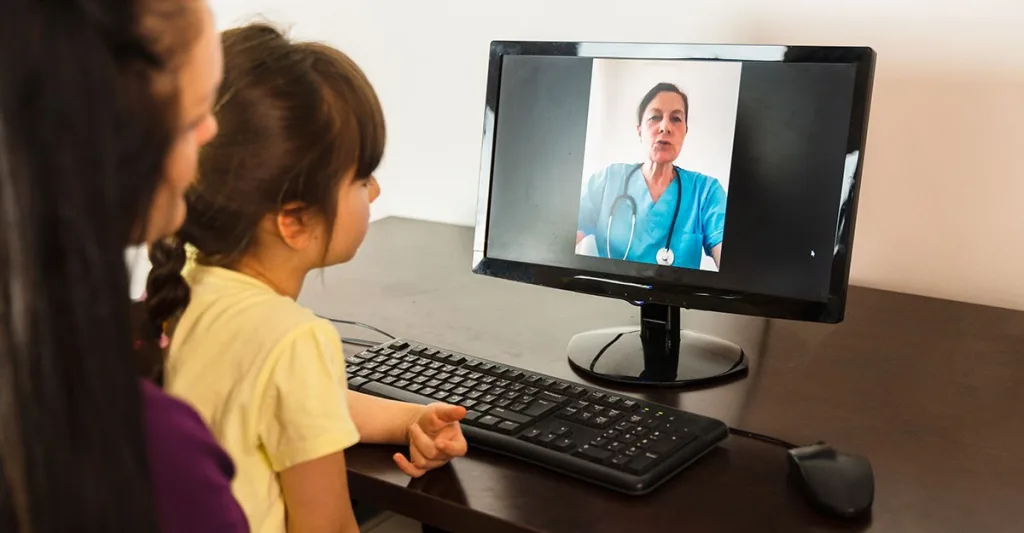Around 12.6 million children under the age of 17 used telehealth services in 2020, according to a report from the Centers for Disease Control and Prevention (CDC).
Telehealth has revolutionized healthcare delivery, offering a range of benefits but also challenges, especially for those in pediatric nursing. With the advancement of technology and the rising demand for accessible healthcare, telehealth has become an integral part of pediatric care.
Let’s explore the benefits and challenges of telehealth in pediatric nursing, providing insights into its impact on healthcare delivery for children and their families.
Pros of telehealth with a pediatric nurse
A pediatric nurse can leverage telehealth to provide better care for their patients and families. Telehealth can provide both nurses and patients with many advantages, including:
Improved access to care
Many families face challenges in accessing specialized pediatric care due to geographic or transportation barriers. Telehealth with a pediatric nurse eliminates these obstacles by allowing healthcare providers to reach patients regardless of their location.
Convenience and flexibility
For families, telehealth offers the convenience of receiving medical consultations without leaving their homes. This flexibility is particularly beneficial for parents who have multiple children or those who find it challenging to take time off from work for medical appointments. Telehealth appointments can often be scheduled more quickly than in-person visits, reducing wait times and enhancing the overall patient experience.
Continuity of care
Telehealth facilitates continuity of care by enabling regular follow-ups and monitoring without the need for frequent in-person visits. This is particularly important for children with chronic conditions, such as asthma, diabetes, or developmental disorders, who require ongoing management and assessment. Continuous monitoring through telehealth can help a pediatric nurse and other providers make timely adjustments to treatment plans and prevent complications.
Enhanced patient engagement and education
Telehealth platforms often include educational resources and tools that can help parents and children better understand their health conditions and treatment plans. This increased access to information can empower families to be more active in managing their family’s health. This method can improve patient engagement by allowing for more frequent interactions between the pediatric nurse and families, fostering a stronger therapeutic relationship.
Cost-effectiveness
For families, telehealth eliminates travel expenses and reduces the need for time off from work. For healthcare organizations, telehealth can increase efficiency and can help reduce emergency room visits and hospital admissions by providing timely care and preventing complications.
Integration of multidisciplinary care
Telehealth enables the integration of multidisciplinary care by allowing various specialists to collaborate on a child's treatment plan. This is particularly beneficial for children with complex medical needs who require coordinated care from multiple healthcare providers. Through telehealth, specialists can easily communicate, share information, and develop comprehensive treatment plans without the need for multiple in-person appointments.
Innovative therapeutic interventions
Telehealth opens up opportunities for innovative therapeutic interventions, such as virtual therapy sessions for children with mental health needs or developmental disorders. Virtual therapy can be more accessible and less intimidating for children, providing a comfortable environment for them to engage in therapeutic activities. Telehealth can facilitate access to specialized therapies that may not be available locally.
Cons of telehealth in pediatric nursing
Despite the benefits of telehealth for pediatric patients, there are also some challenges, including:
Technological barriers
Not all families have access to the necessary devices or reliable internet connections to participate in telehealth appointments. This digital divide can exacerbate existing healthcare disparities, particularly for low-income or rural families.
Limited physical examination capabilities
While certain assessments can be conducted visually or with the assistance of parents, some aspects of a physical examination, such as palpation or auscultation, cannot be replicated through telehealth. For a pediatric nurse, this limitation can affect the accuracy of diagnoses and the quality of care.
Privacy and confidentiality concerns
Ensuring that telehealth platforms comply with regulations such as the Health Insurance Portability and Accountability Act (HIPAA) is a must to protect sensitive patient data. Families must have a private space for telehealth appointments to ensure confidentiality during consultations.
Patient and provider adaptation
Children, especially younger ones, may find it difficult to engage with healthcare professionals through a screen. Similarly, a pediatric nurse and other healthcare professionals may need to adjust their communication and assessment techniques to effectively interact with children and their families in a virtual setting.
Ensuring quality of care
Pediatric nurses and other healthcare professionals must ensure that telehealth consultations are as thorough and effective as in-person visits. This requires adapting clinical guidelines and developing protocols for telehealth-specific scenarios. Continuous training and education are essential to uphold the standard of care.
Building rapport and trust
Building rapport and trust with pediatric patients and their families is critical. Telehealth can make this more challenging, as the physical presence and non-verbal cues that contribute to building a therapeutic relationship are limited. A pediatric nurse must develop strategies to effectively connect with families and establish trust in a virtual environment.
Technical support and troubleshooting
Technical issues, such as software malfunctions or connectivity problems, can disrupt telehealth appointments and affect the quality of care. Healthcare professionals as well as families must have access to technical support to address these issues promptly. Additionally, providers may need to allocate time and resources for training on telehealth platforms and troubleshooting common problems.
The future of telehealth in pediatric nursing
The future of telehealth in pediatric nursing is promising, with continuous advancements in technology, expansion of services, and more:
Advancements in telehealth technology: Innovations such as artificial intelligence (AI) and machine learning can enhance the capabilities of telehealth platforms, providing more accurate diagnoses and personalized treatment plans.
Integration with electronic health records (EHR): Seamless integration allows for the efficient sharing of patient information, reducing administrative burdens, and ensuring that healthcare providers have access to comprehensive patient data during telehealth consultations.
Expansion of telehealth services: The expansion of telehealth services can provide more comprehensive care to pediatric patients. This can include the incorporation of telehealth into school health programs, enabling school nurses to consult with a pediatric nurse or specialist remotely.
Research and evidence-based practice: Ongoing research and evidence-based practice are essential to the continued success of telehealth in pediatric nursing. Studies on the effectiveness, safety, and patient satisfaction of telehealth can provide valuable insights and inform best practices.
Enhancing patient and family engagement: Future efforts can focus on enhancing patient and family engagement in telehealth. This can include developing interactive and user-friendly telehealth platforms, as well as the incorporation of gamification and other engagement strategies.
Telehealth presents numerous opportunities and challenges for a pediatric nurse. While it improves access to care, convenience, and cost-effectiveness, it also requires addressing technological, regulatory and adaptation challenges. By leveraging advancements in technology, providing continuous training, and advocating for supportive policies, pediatric nurses can optimize the benefits of telehealth and ensure high-quality care for their patients.
Whether you're actively seeking a new role or assessing your next steps, explore Nurse.com's talent marketplace to help match your experience and skills to the best-fitting role.







